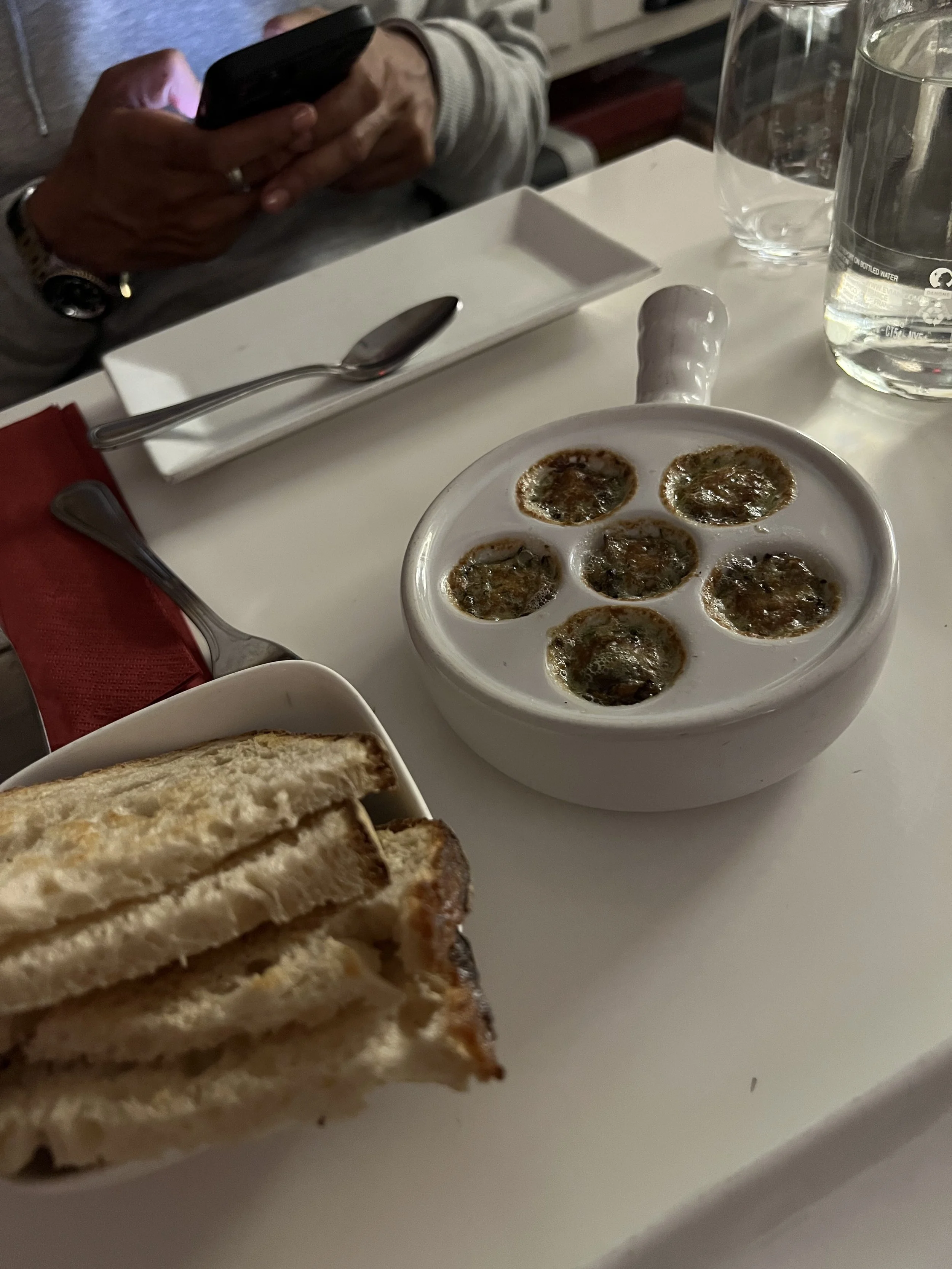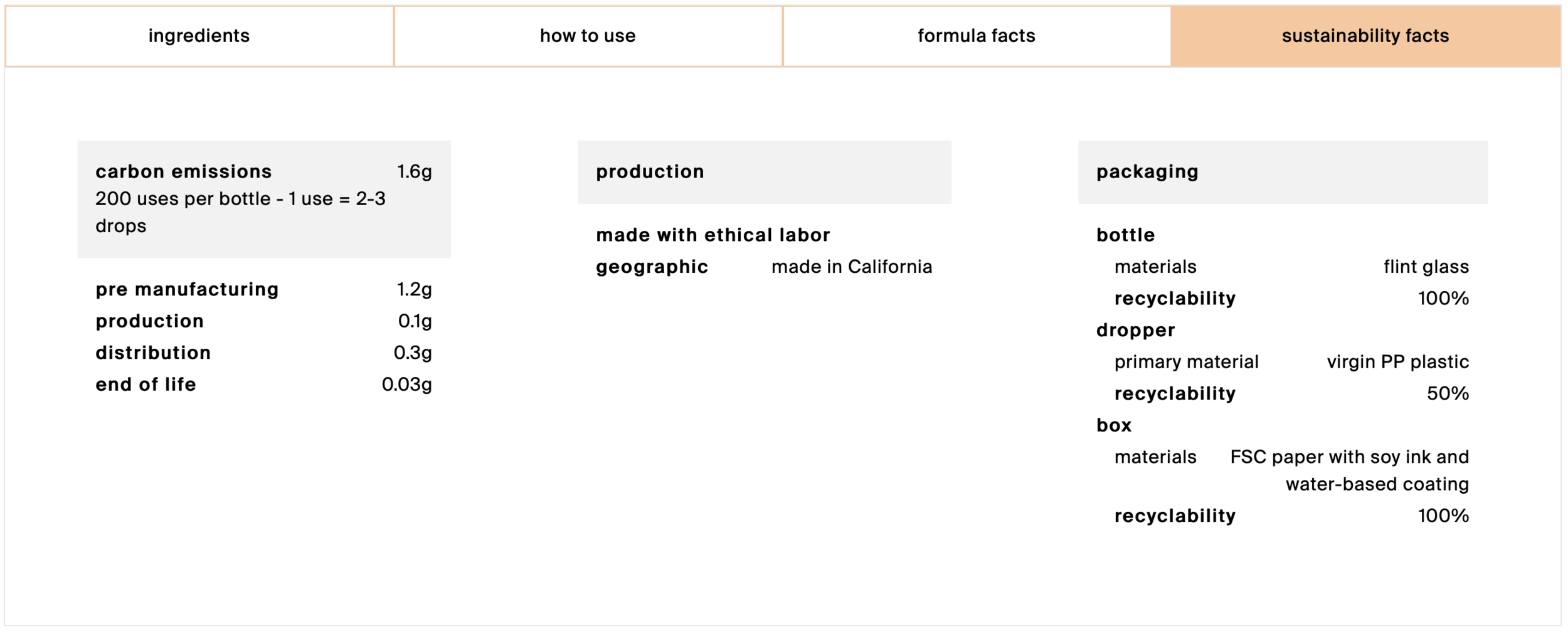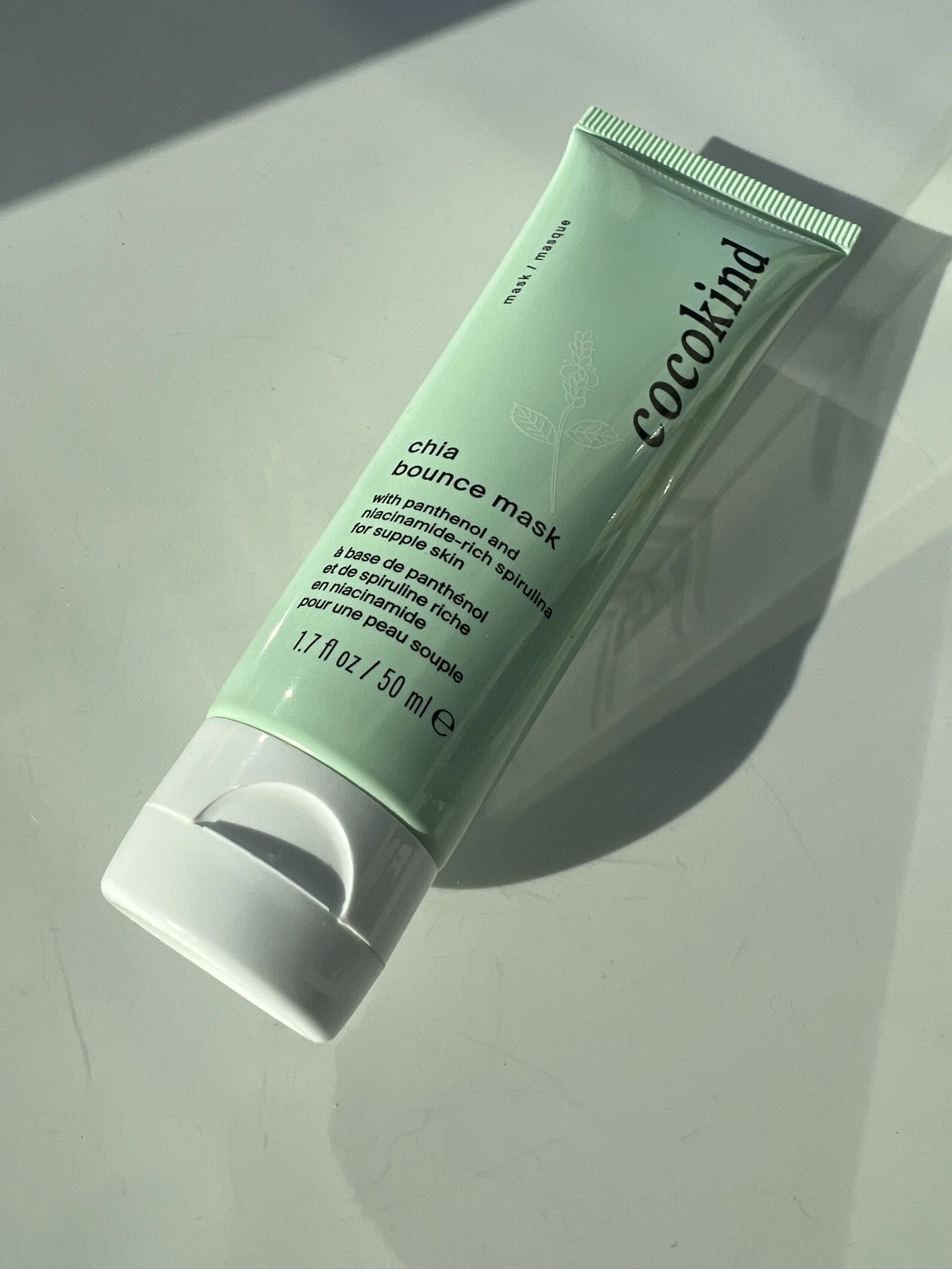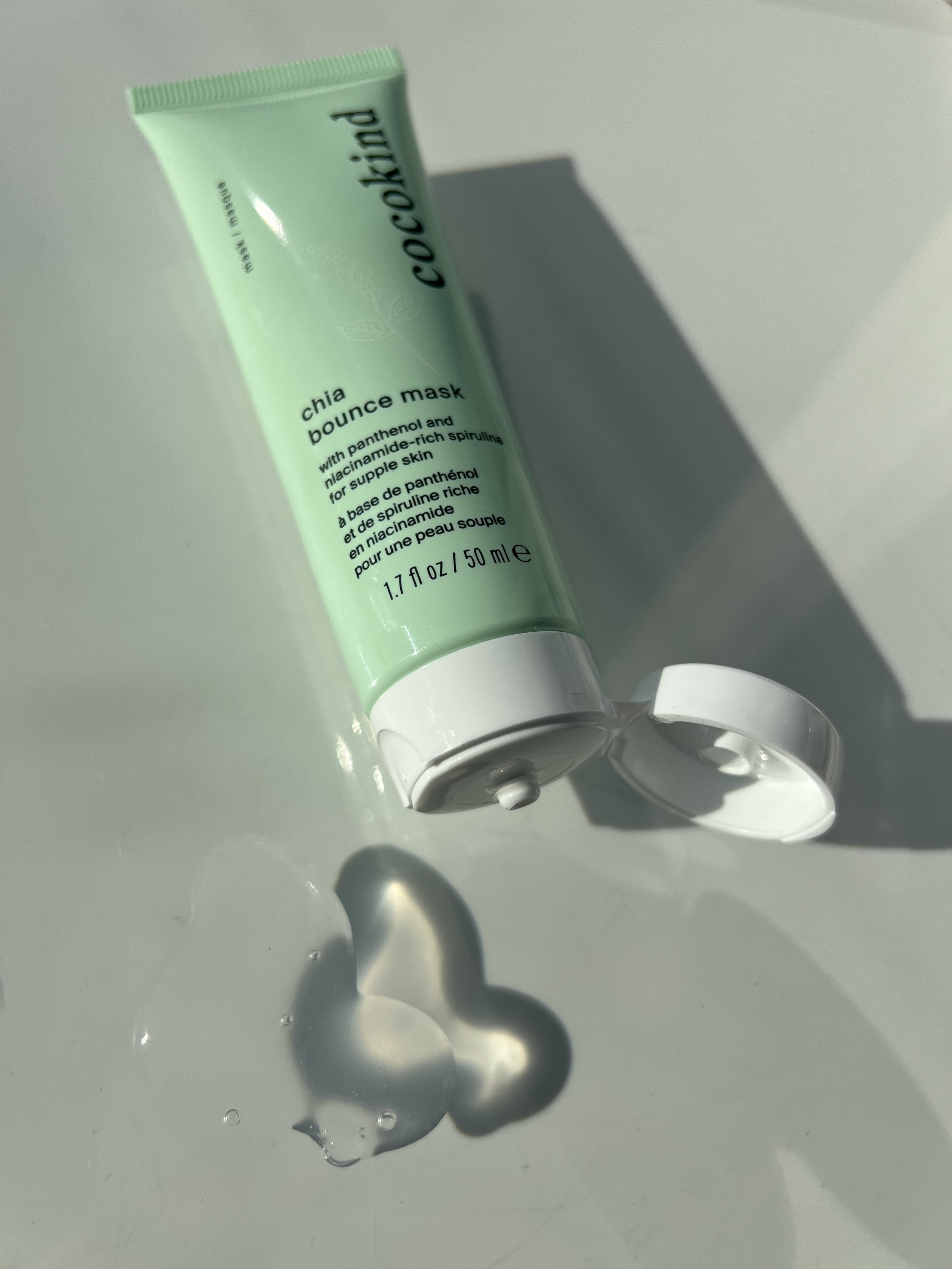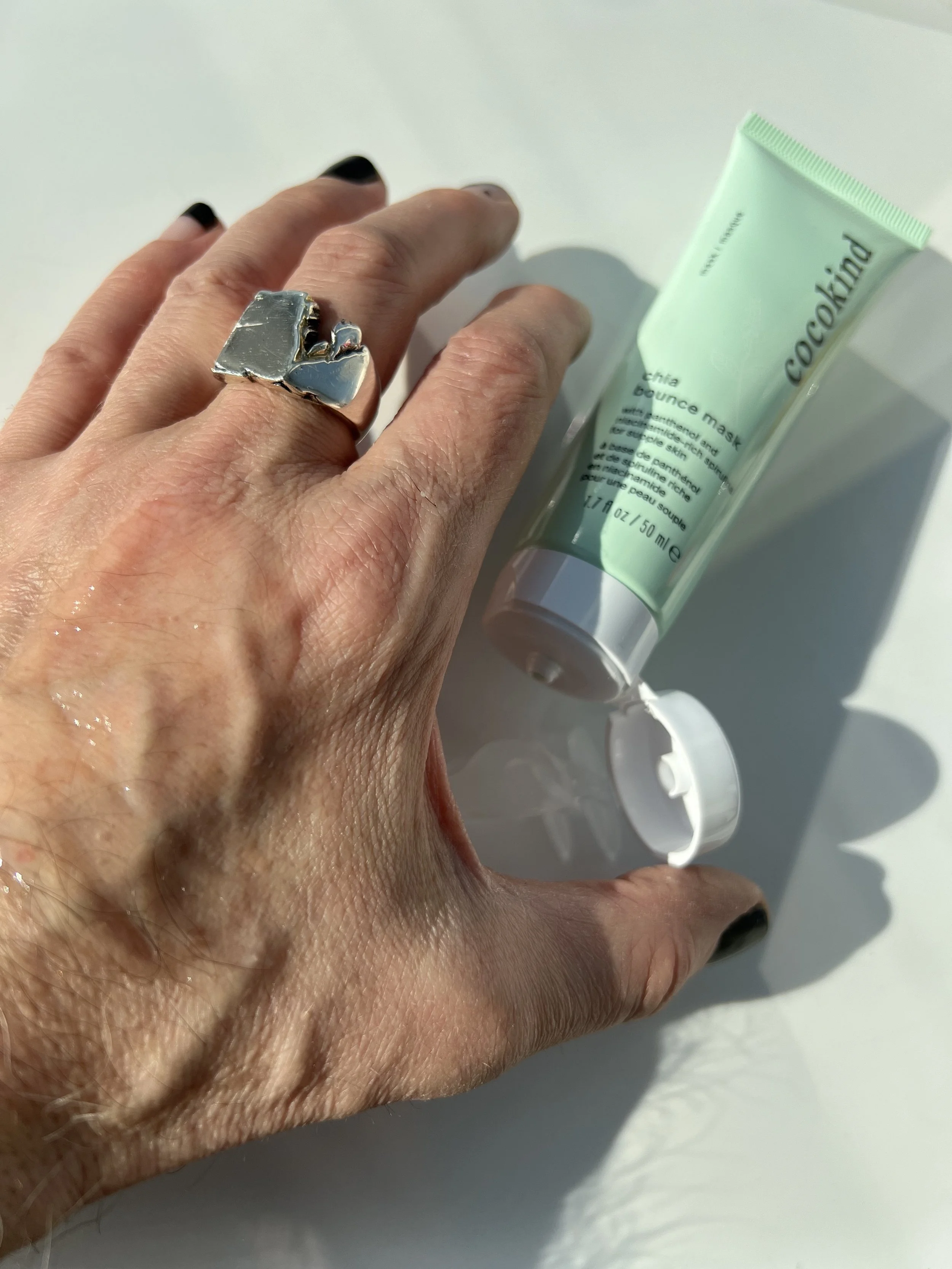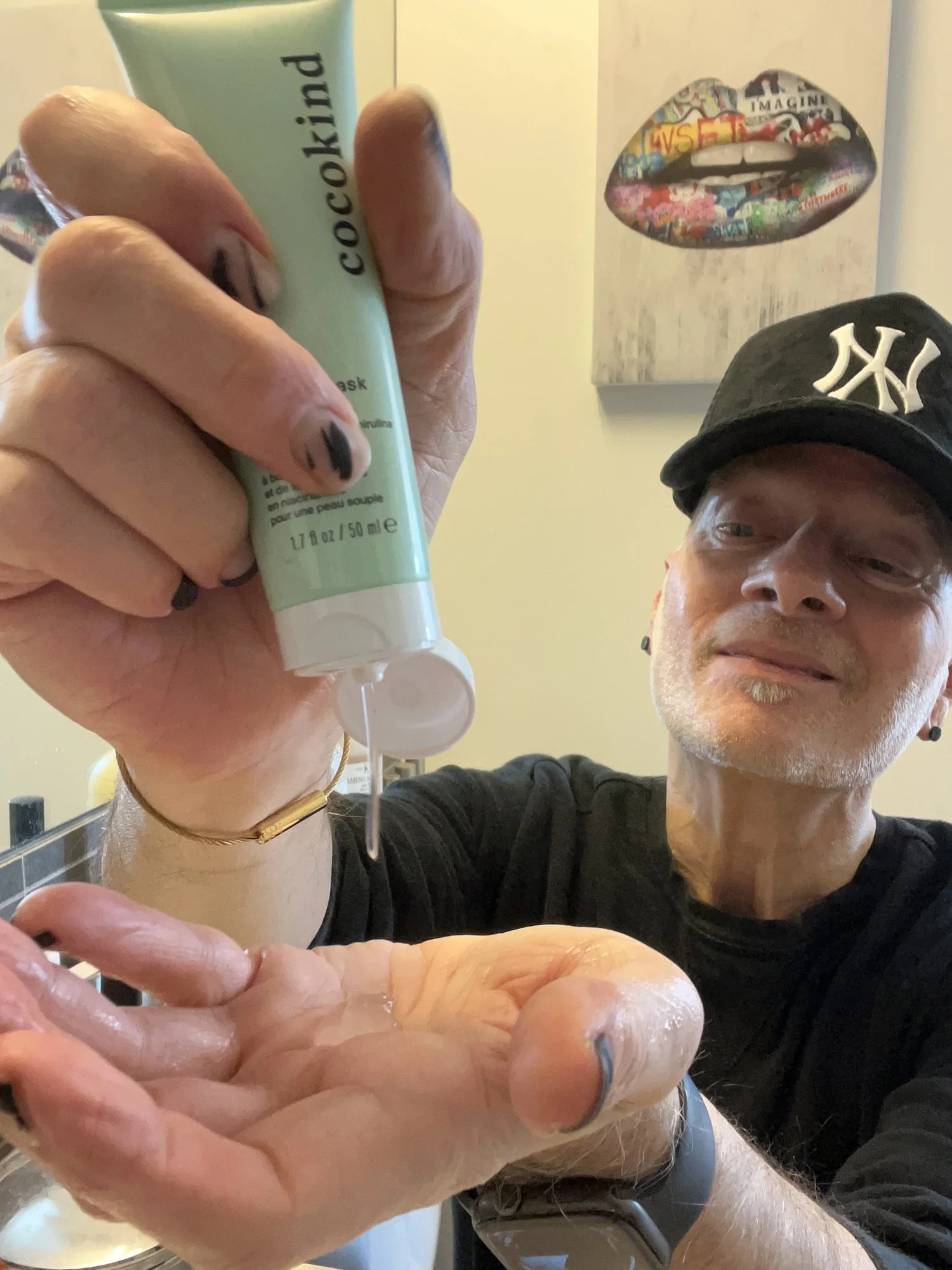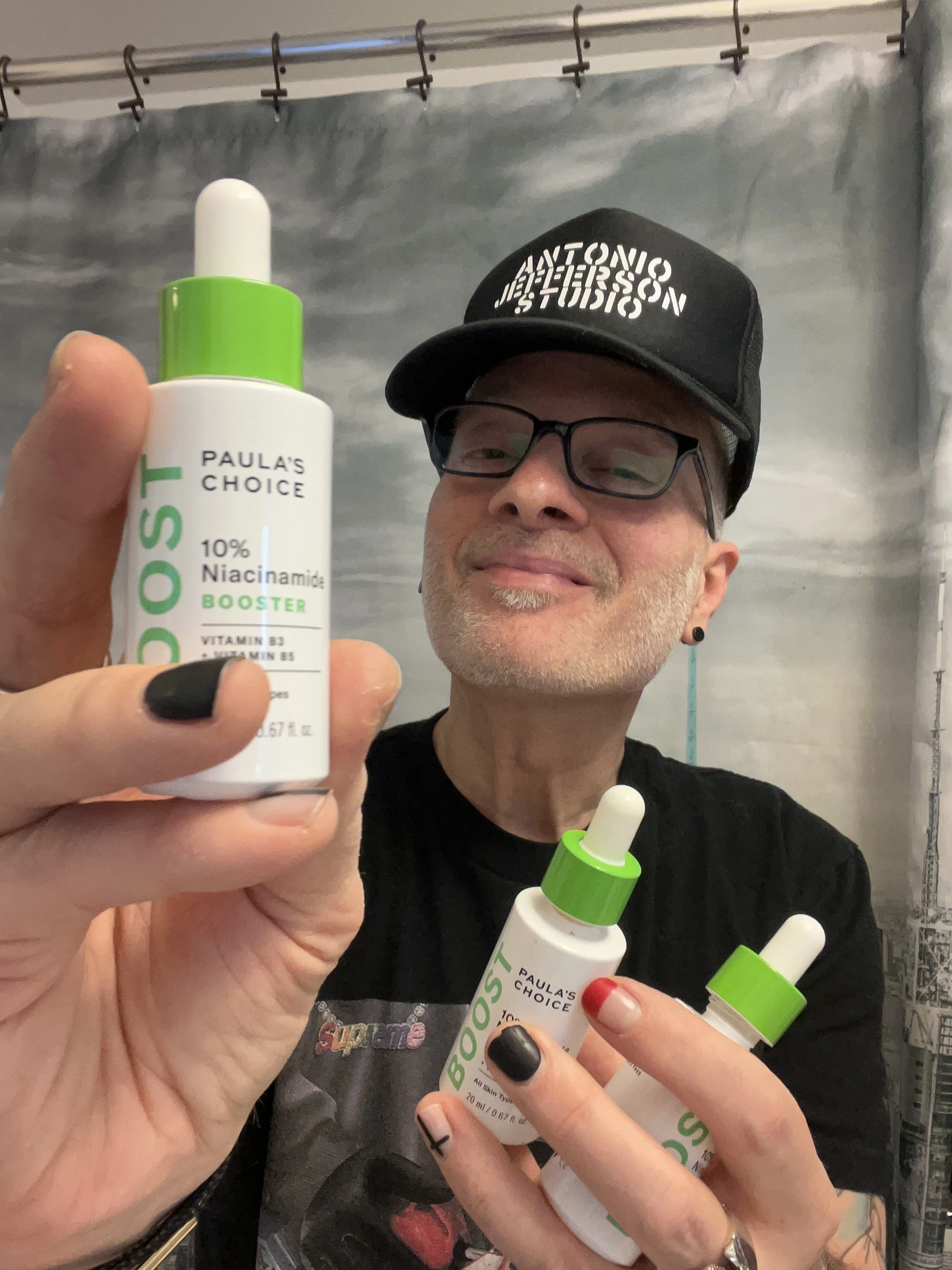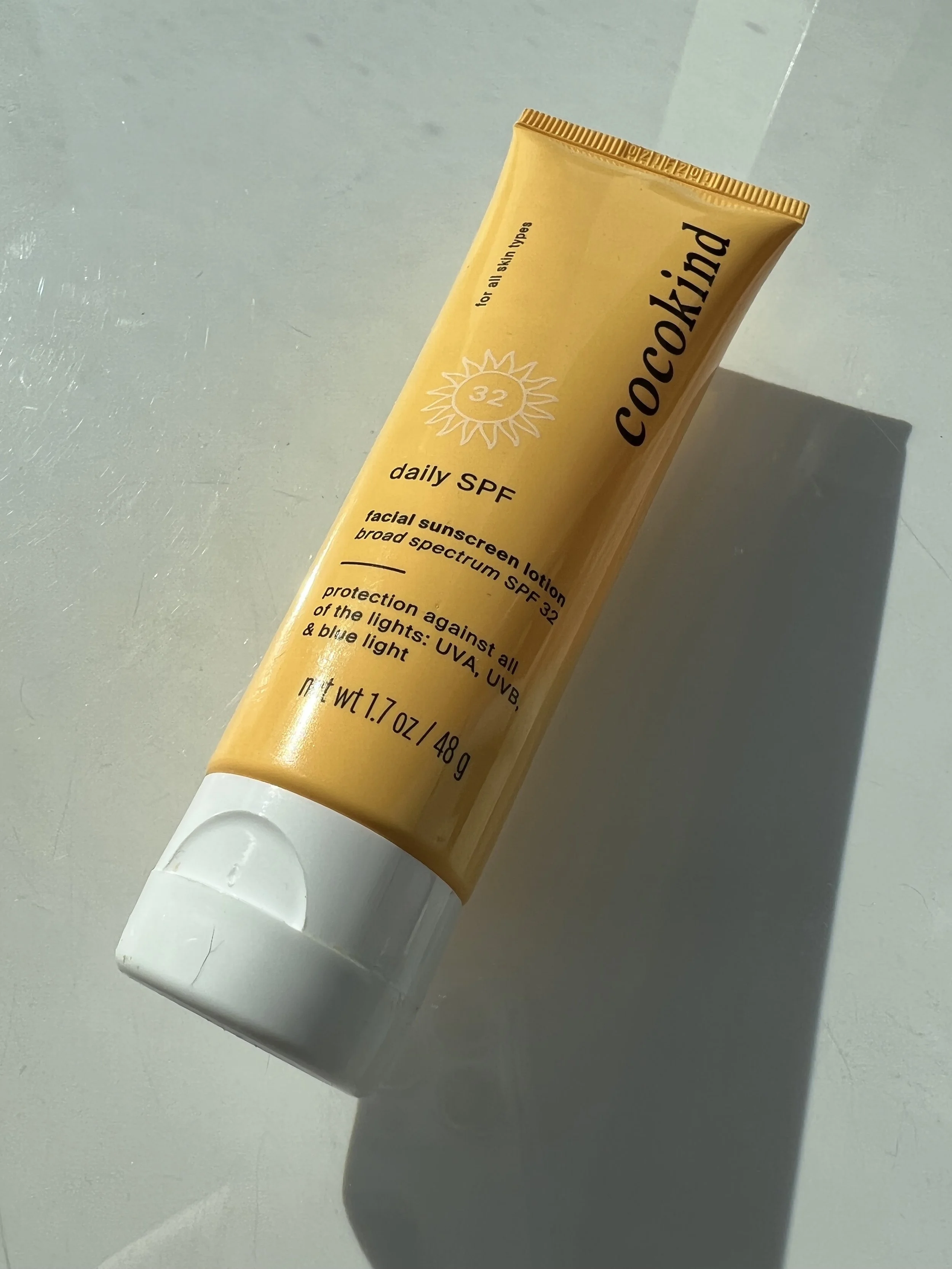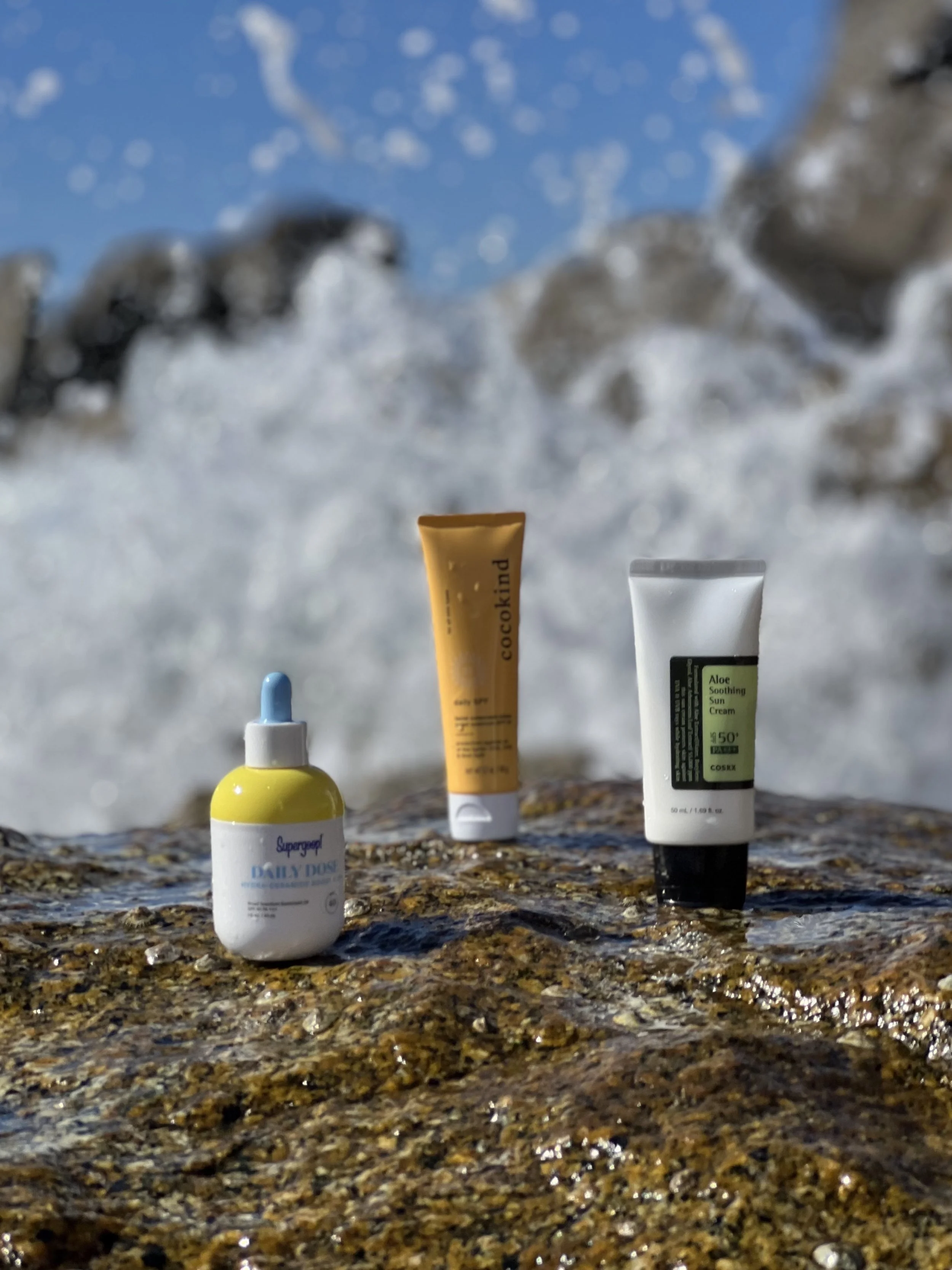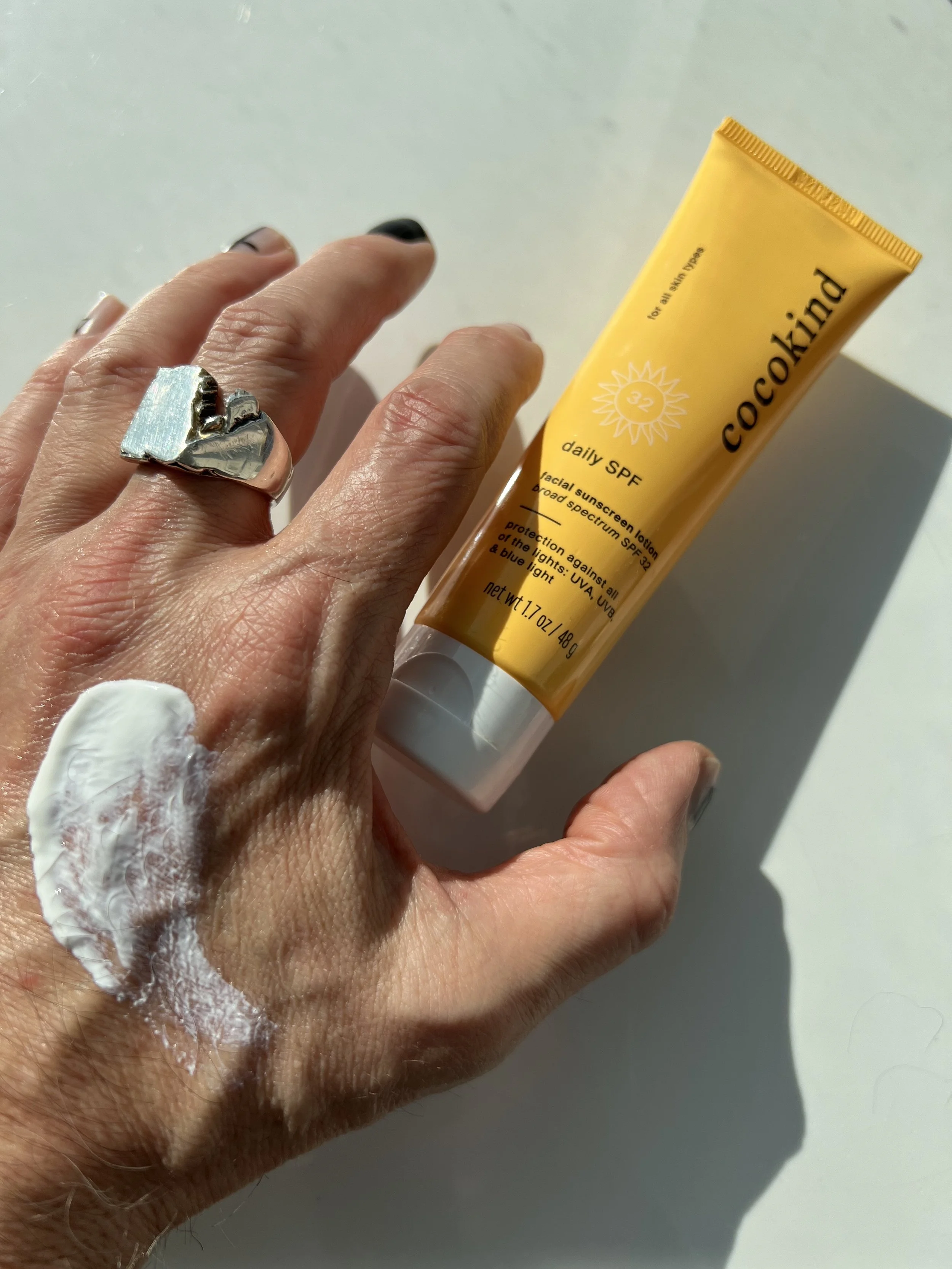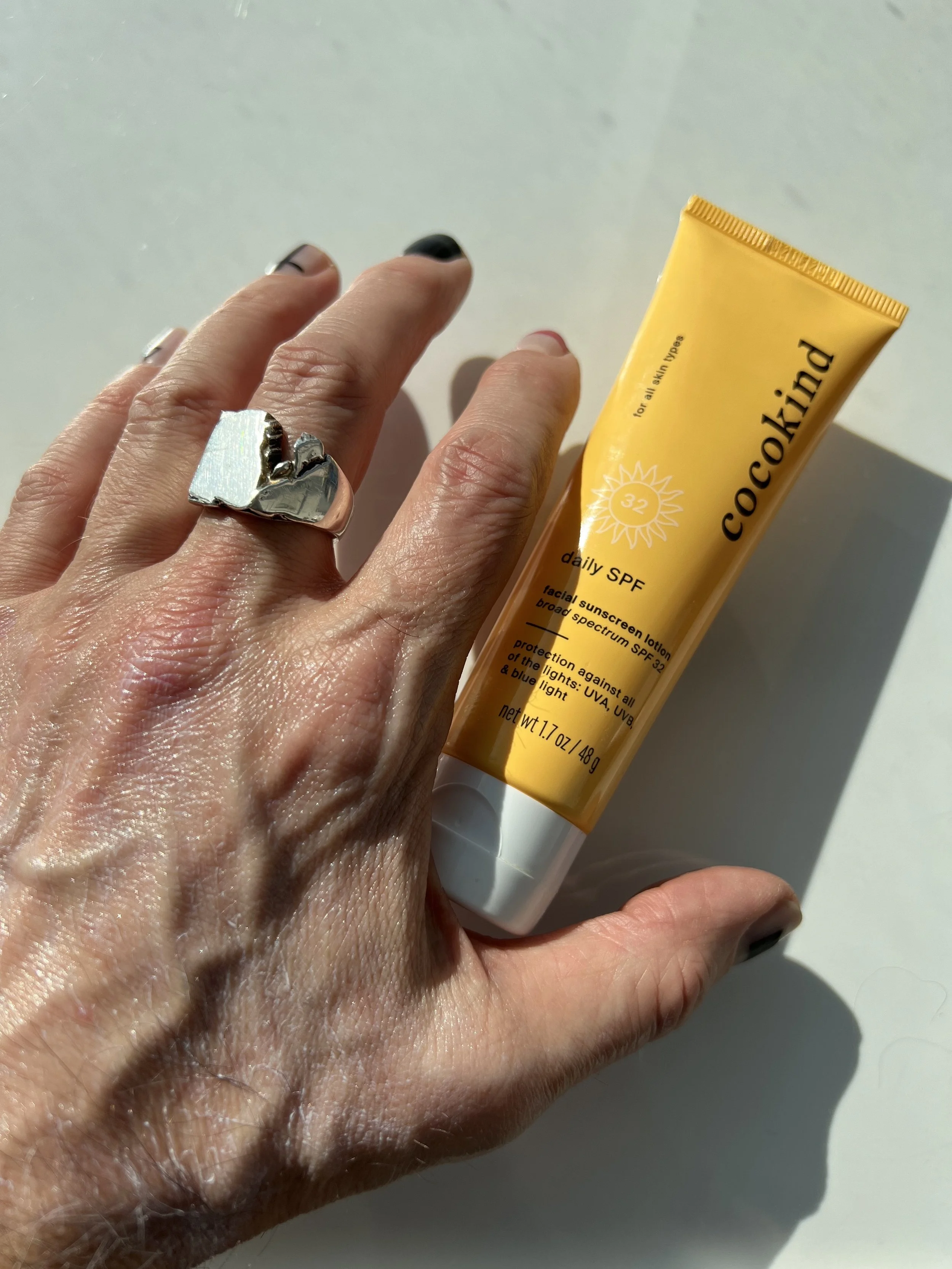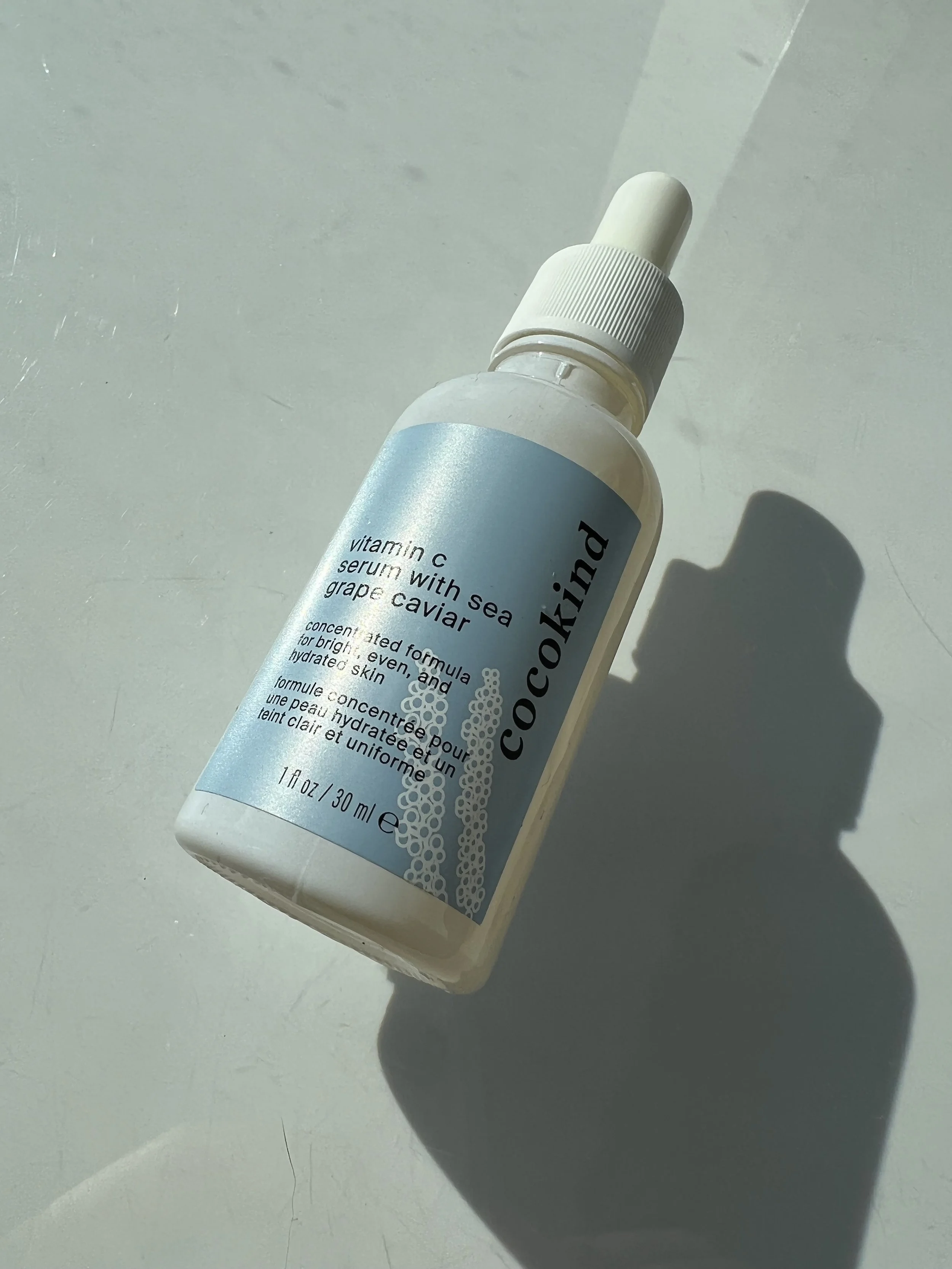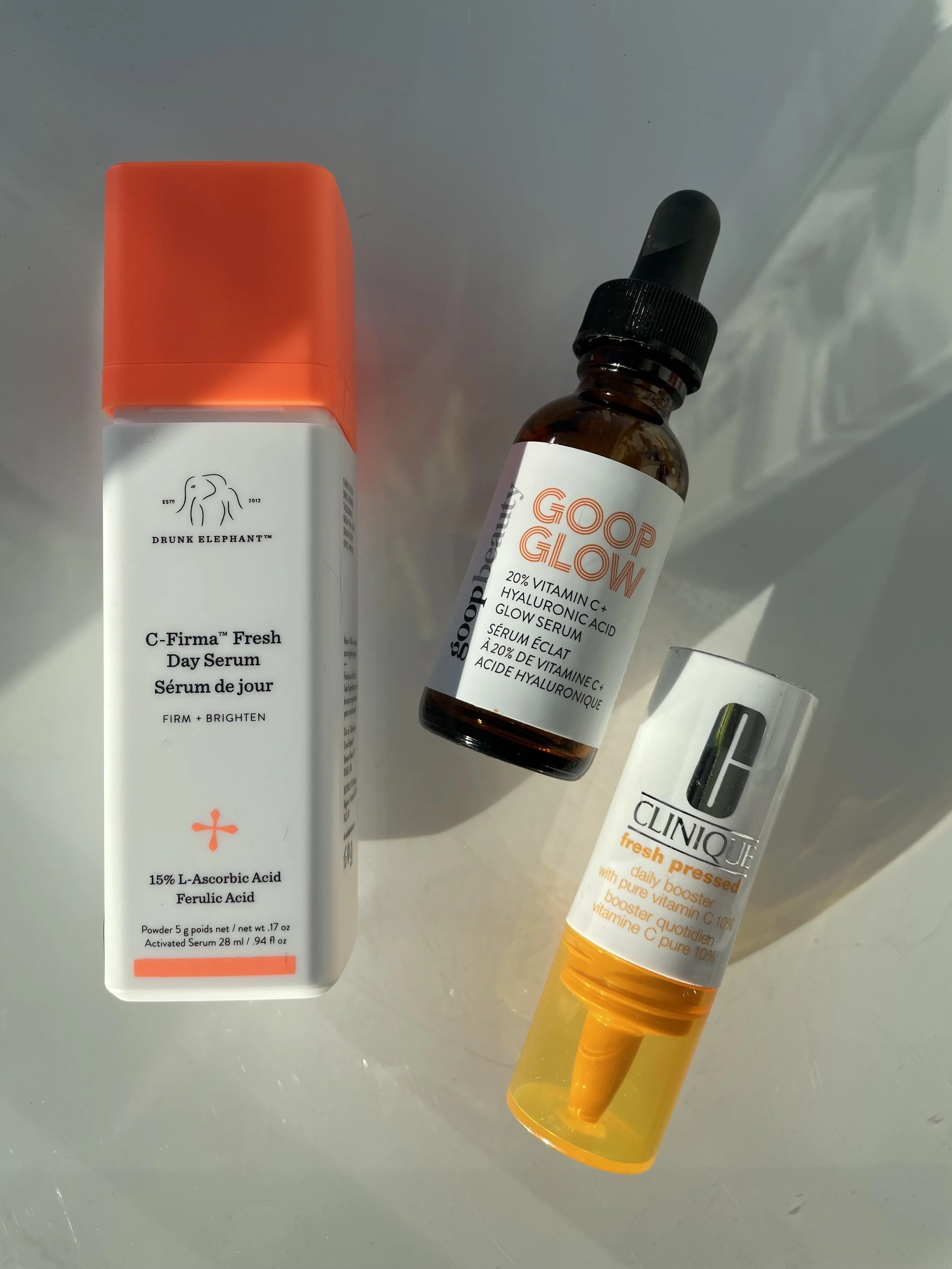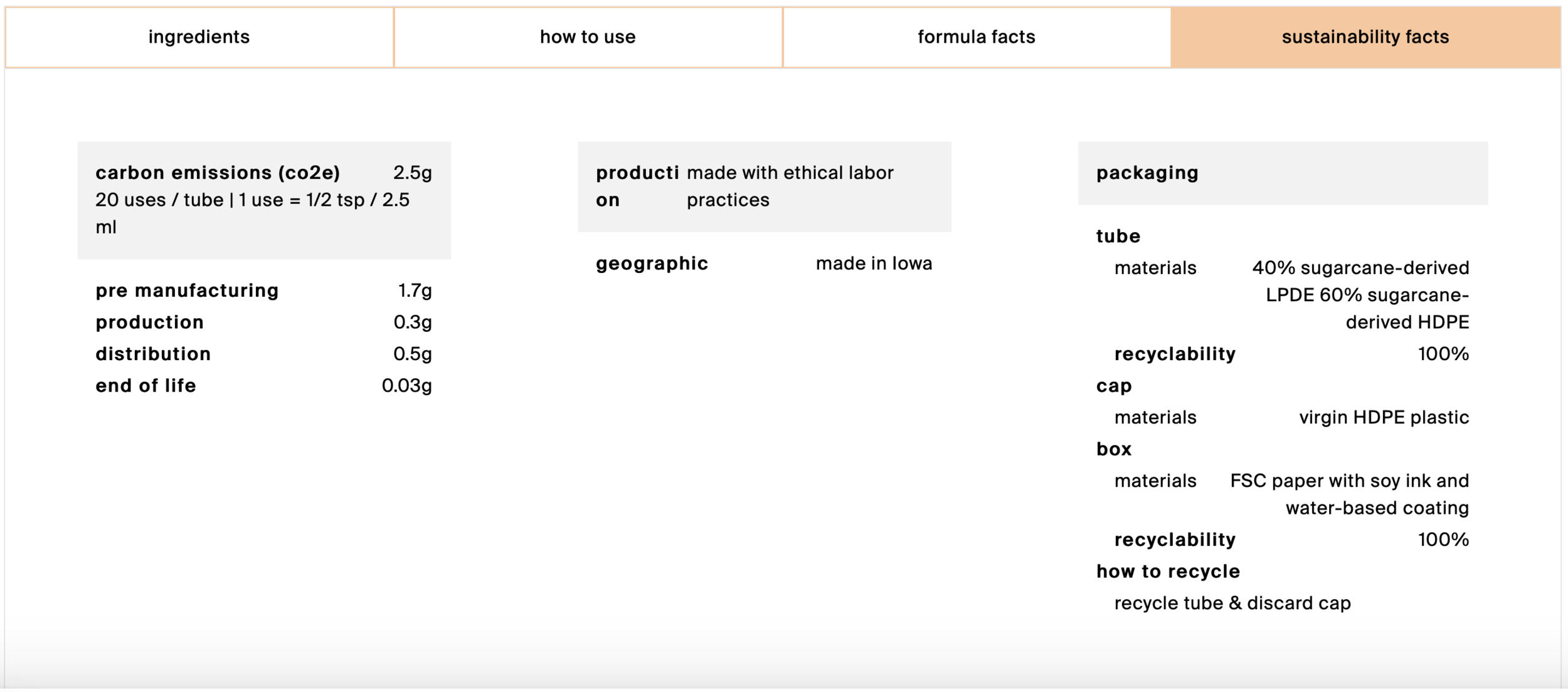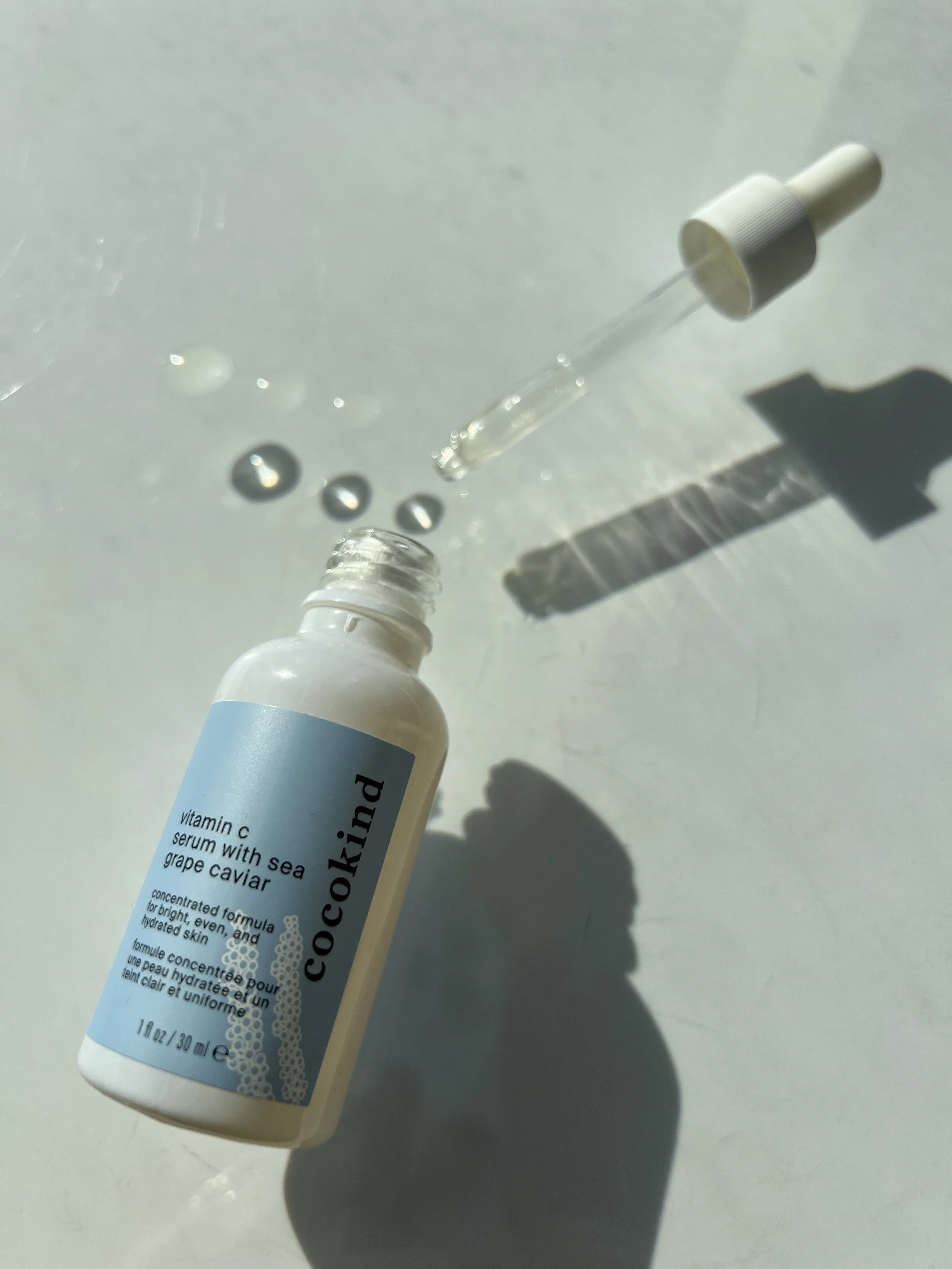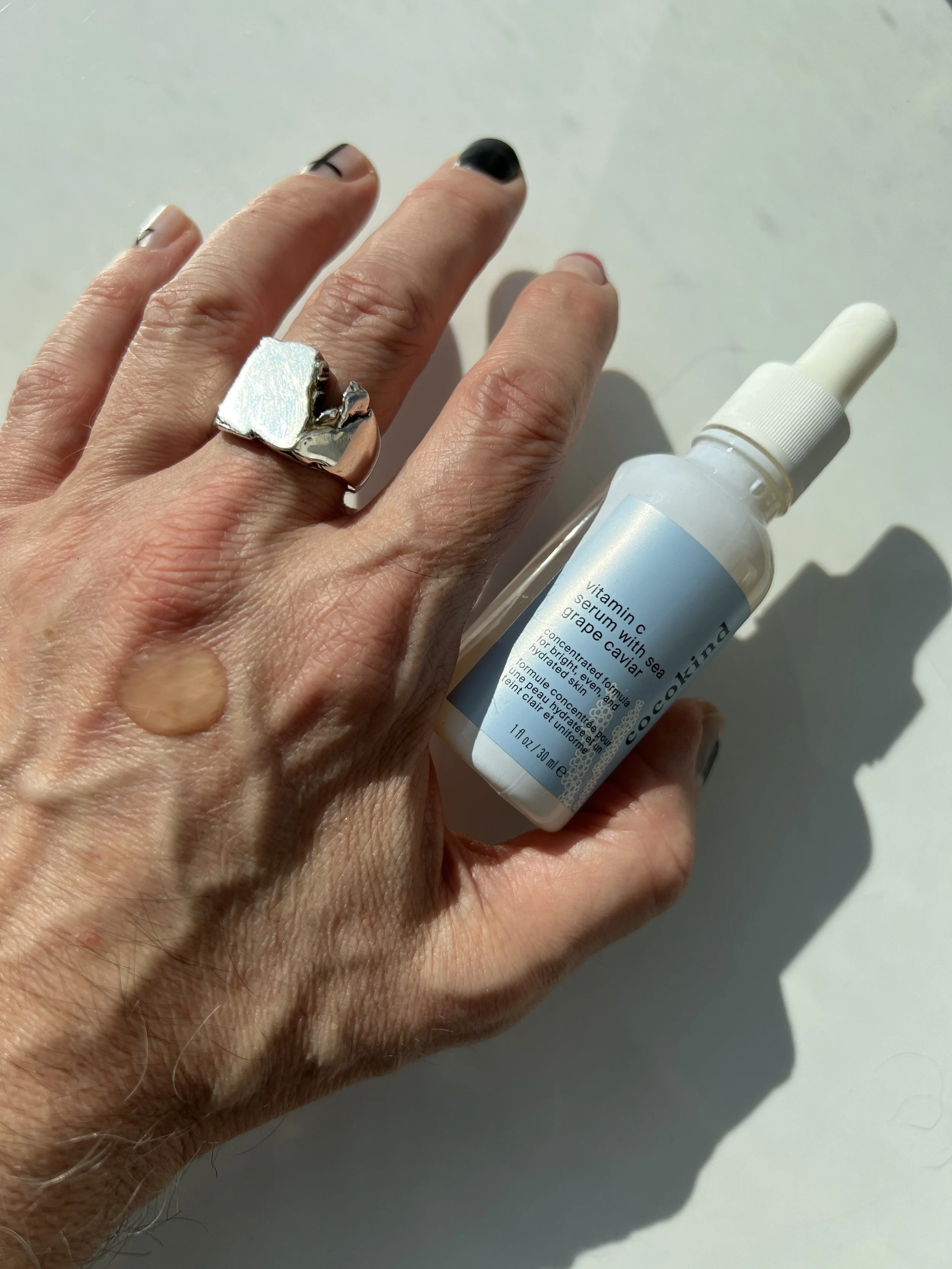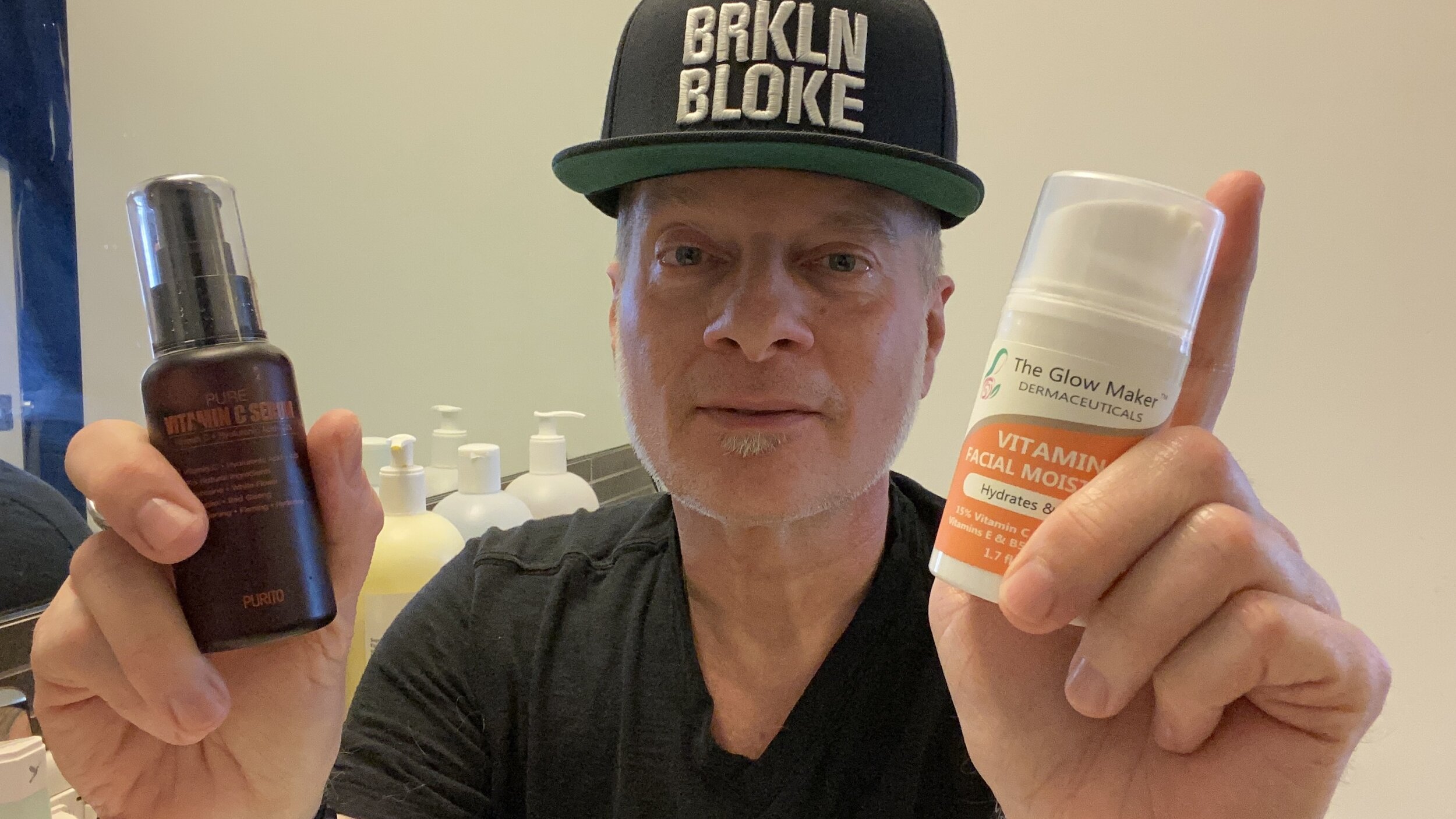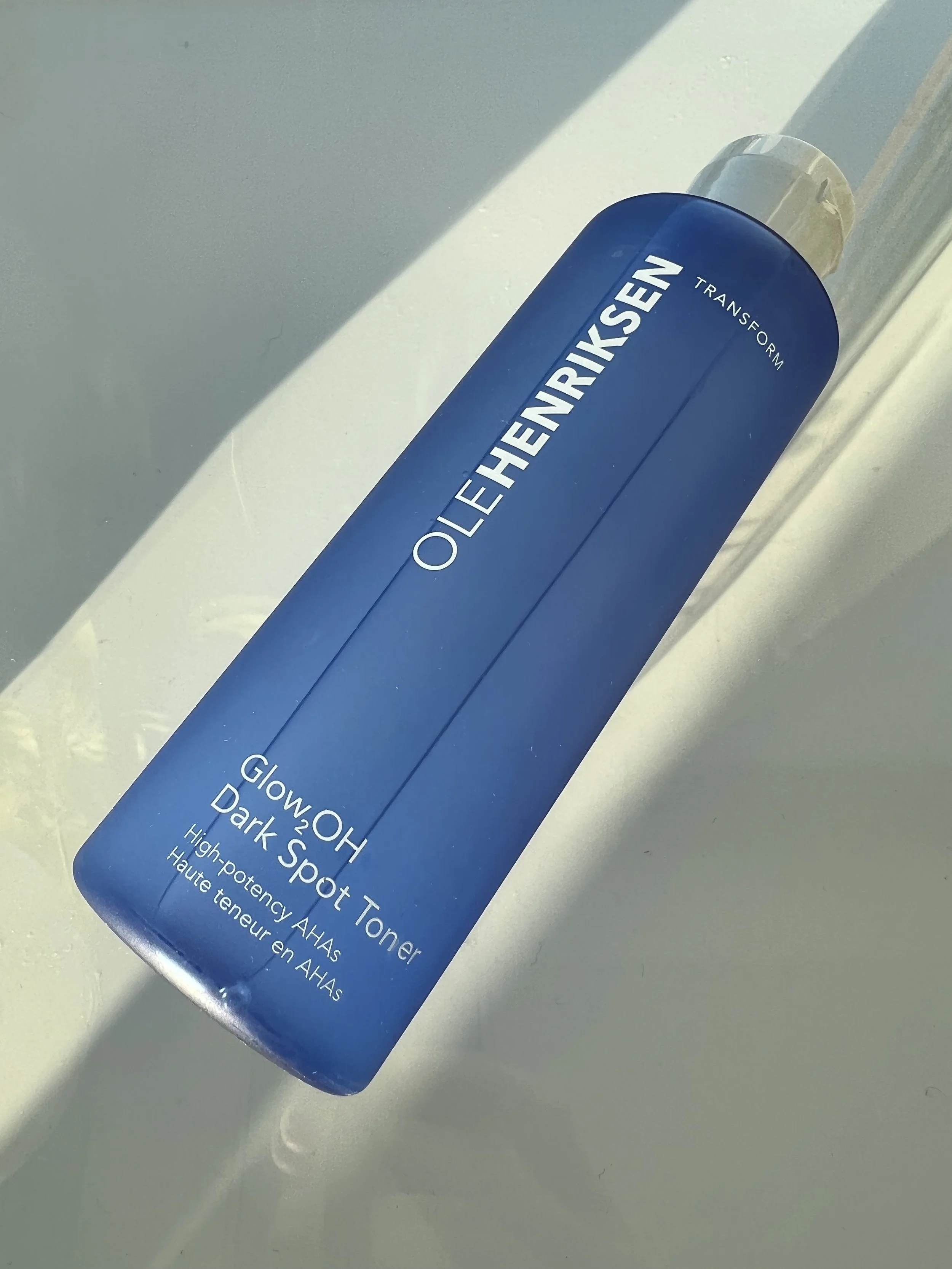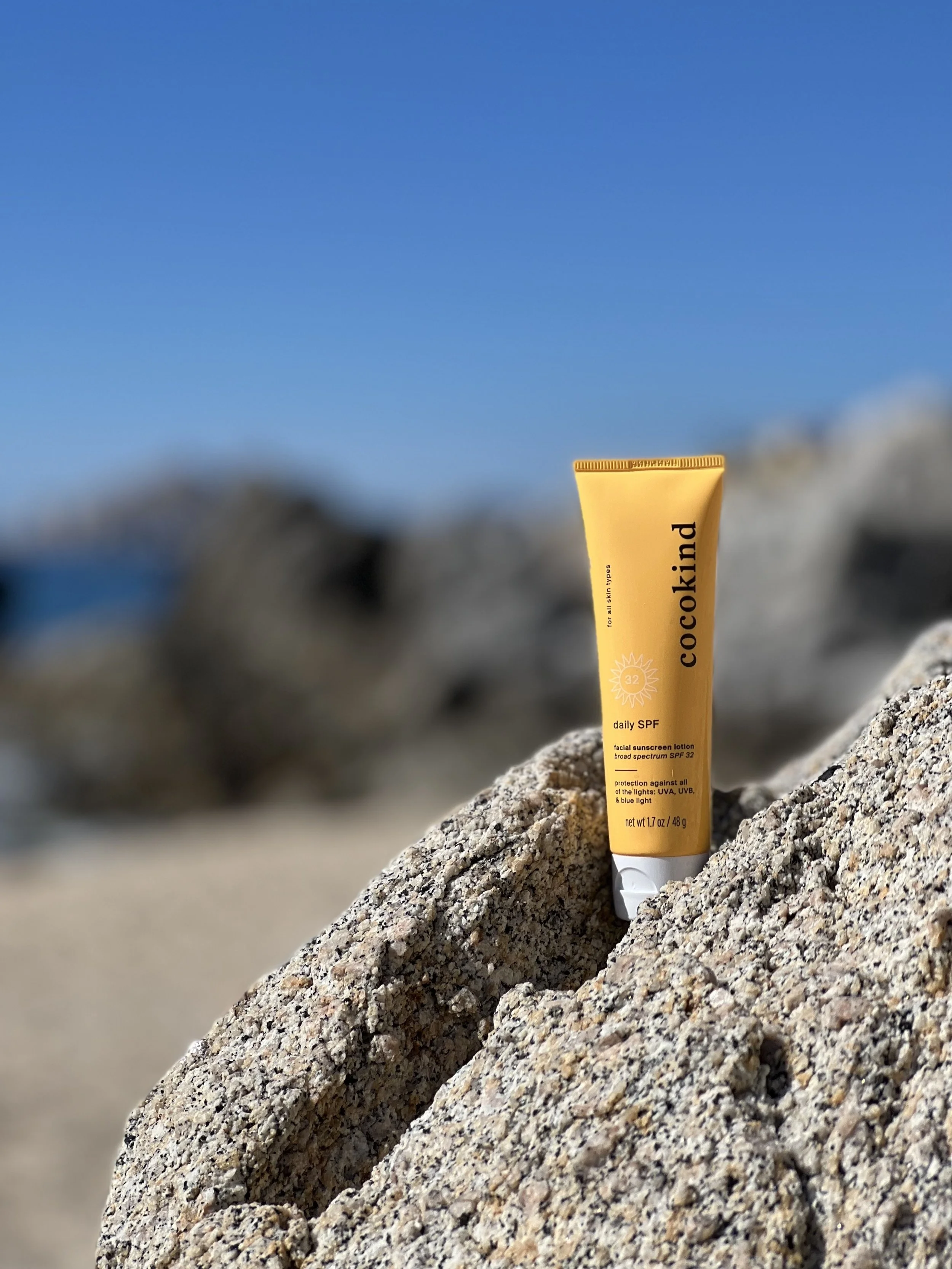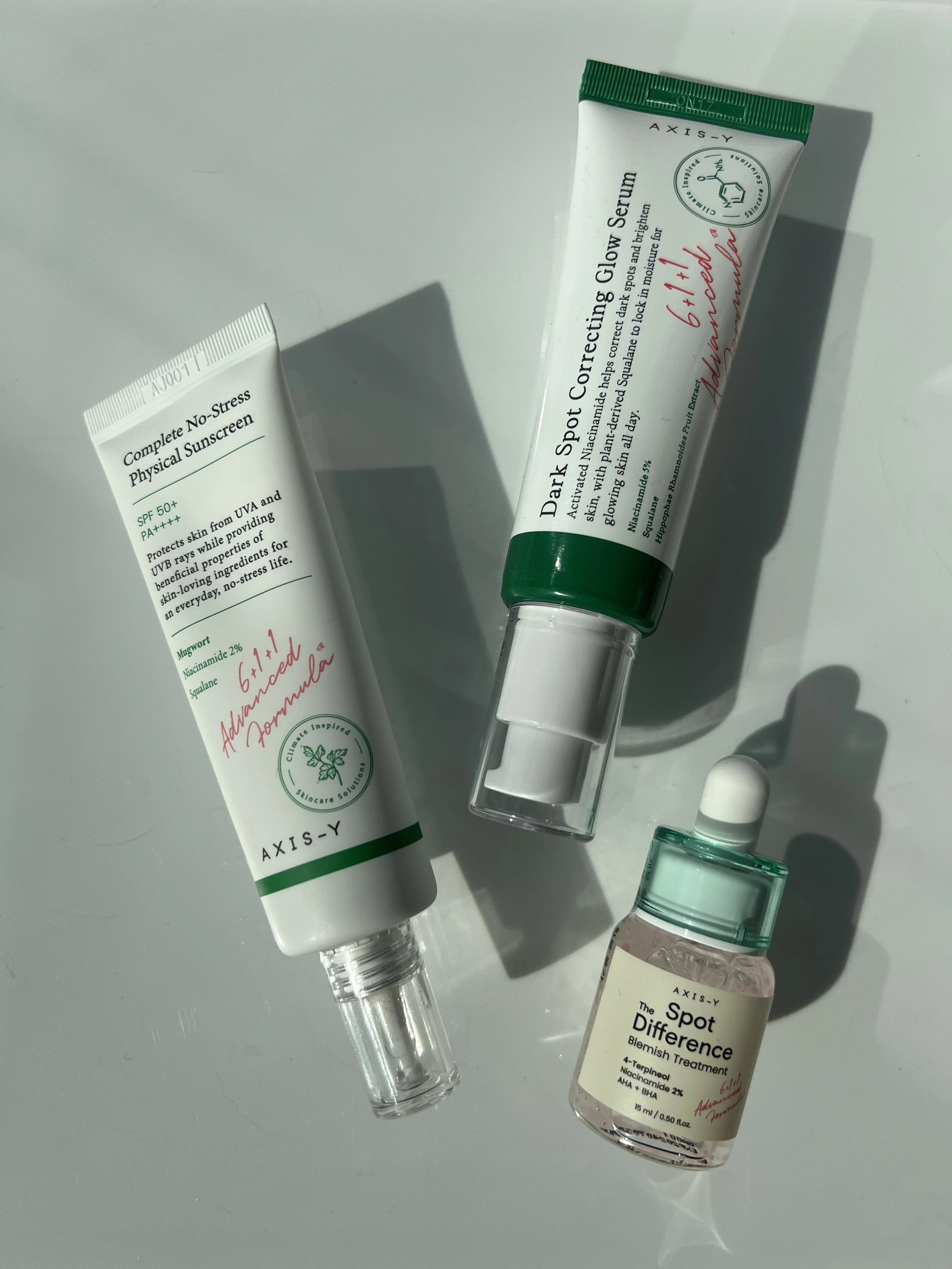BRANDS I'M INTO: COCOKIND - COOL, CLEAN, SUSTAINABLE SKINCARE - BEST MINERAL SUNSCREEN, BEST VITAMIN C SERUM FOR OILY SKIN
The past week felt like the most normal in over two years. New York City feels like it’s almost fully emerged from the pandemic — at least as close as we’ve been to normal yet.
Restaurants are crowded again. The subways are filling up. And as of today, New Yorkers are freed from the requirements that we wear a mask indoors and show proof of vaccination when dining.
(I’m proud to say that 87% of adult New Yorkers are fully vaccinated!)
Taking advantage of these new-found freedoms, I dined out with friends quite a bit this week. My vegan bestie and I discovered an amazing vegan French restaurant in the heart of Greenwich Village called Delice & Sarrasin.
Unless you’ve been a vegan since birth, there are things you will always miss eating, and will always seek substitutions for. Of course, you find new vegan foods to love, appreciate and even crave. But, among the foods I miss the most are fried calamari and breaded chicken cutlets. I really, really miss a sliced turkey sandwich with tomato and mayo through!
There are foods that simply can’t be replaced. Or so I thought. Like escargot. Seriously, how are you going to replace the silky, buttery nirvana that is escargot? Well, I’m here to say that the vegan escargot at Delice & Sarrasin is exceptionally satisfying. It’s made with oyster mushrooms, cooked and served just like the real thing. C’est extraordinaire!
This past week, I was also due to see my neurologist for my quarterly check-up and Botox for migraine treatment. Dr. Grant asked my permission to have an intern present, a student she’d invited to observe the Botox treatment and learn about my personal experiences as a chronic migraineur. I’ve come a long way in my treatments, having started out with up to 28 migraine days a month for well over two years.
Today, as I write this, I am migraine-free most days of the week, or am managing a low-grade, low-intensity and low-pain migraine. I’ll take that over anything! It’s been a blessing to achieve the recovery that I have.
Together, we talked the young man through my progression, the treatments that have worked for me, and those that haven’t. During the back and forth, one thing she said struck me. And it struck me hard. Acknowledging how difficult, even grim, things were for me when she first began treating me in the summer of 2018, Dr. Grant shared that never expected me to recover as well as I had.
The very idea that an expert neurologist at one of the leading migraine headache institutes in the world didn’t believe I’d recover horrified me. But it also reassured me of the power of raw human will to overcome adversity. I stuck it out. I never stopped fighting to get better and to figure out how to find my way back to me…
The skincare stuff starts here.
Several months ago, I had the great fortune of discovering this cool, clean skincare brand from San Francisco, California, called Cocokind. With some of the best clean face serums, face creams, and facial sunscreen products available, the brand has consistently delighted me in surprising ways. Cocokind has been one of my favorite brand discoveries of the past year.
While I’ve been super intrigued by their safe, toxin-free, and effective skincare formulas, it’s their firm commitment to sustainability that sets them apart. As I’ve shared in every Cocokind product review and blog article since the summer, the brand offers the most in-depth, product-specific information on a web page that I’ve ever seen. The level of information is rivaled only by Paula’s Choice. And even my favorite skincare brand focuses solely on ingredient and formula specifics.
(Yes, Paula’s Choice is my favorite skincare brand and the Paula’s Choice 10% Niacinamide Booster is my favorite skincare product!)
Be sure to check out cocokind.com and the in-depth product recyclability and sustainability details for yourself. It’s cool stuff that no one else is doing!
Cocokind’s commitment to transparency goes beyond their web messaging. The brand’s product cartons are packed with formula and sustainability facts. Again, like no other. As a skincare copywriter who’s written hundreds of product cartons, I can attest to the fact that’s it’s no small feat to make space for information on a carton beyond what’s required. How they pull that off is nothing short of extraordinary.
From the brand:
“New to our packaging are our sustainability facts, which break down the carbon footprint for a product’s life cycle. Not only will measuring this information allow us to make future commitments to reduce our carbon footprint, but sharing it can help you learn what your impact is on the environment when you consume cocokind!”
And their products are surprisingly affordable, too!
In the early fall, I was super into the brand’s $19 Revitalizing Eye Cream. It’s a great formula with a dense, silky texture that makes it ideal for a seasonal drop in temperatures. It’s just thin enough to dispense from a tube. (I prefer well-formulated eye creams that aren’t in jars!) And Revitalizing Eye Cream has one of those cooling metal applicator tips. It’s a real pleasure to use.
Cocokind’s $18 Oil to Milk Cleanser is a similarly pleasurable formula. If you’re not a fan of cleansing balms because they can be too rich and heavy on the skin, this one is super lightweight and has a light, milky texture when emulsified with warm water, making it surprisingly easy to wash off. I believe it to be most ideal for oily skin — something you rarely find in a cleansing balm. You can catch my review of the Cocokind Oil to Milk Cleanser on the blog here.
PRODUCT REVIEW: COCOKIND OIL TO MILK CLEANSER - BEST CLEANSING BALM FOR OILY SKIN
Perhaps my favorite of the brand’s products is the Cocokind Daily SPF Facial Sunscreen Lotion — one of three sunscreens I took with me on a trip to Cabo, Mexico, in January. A 100% mineral sunscreen, it’s become one of my favorites and a go-to in my morning skincare routine.
Formulated with 21% Zinc Oxide, Daily SPF is relatively lightweight, with that bright white texture common to a mineral sunscreen made with Zinc Oxide. It blends right in. And, as with Cocokind’s Revitalizing Eye Cream and Oil to Milk Cleanser, it’s ridiculously affordable at just $25. Read more about Daily SPF just below.
Today, I’m excited to share three of my favorites from Cocokind, including my newest discovery — the Cocokind Vitamin C Serum with Sea Grape Caviar, one of the best Vitamin C serums for oily skin. It’s so wonderful…
Cocokind | Chia Bounce Mask
It’s been crazy dry and cold in New York City the last few weeks and my complexion has been looking a bit lifeless and lackluster. I do all I can to keep my skin hydrated and prevent trans-epidermal water loss (TEWL). Of course, that starts with a humectant serum. Humectant molecules like Hyaluronic Acid, Glycerin and Aloe Vera bind to the water in the skin’s layers and lock it in like a sponge.
Application of a humectant serum is part one in my bookended process to keep my skin healthy and hydrated. I’ve shared my “Lock and Block” strategy on the blog multiple times but it always bears repeating, especially during the low-humidity months of winter.
The Skincarma “Lock and Block” Prevents Dehydration
To start, preventing dehydration in the first place requires drinking enough water. That differs for each of us based on our weight, the foods we eat, and the climate we live in. It’s even more important during colder periods.
A good rule is to drink one ounce of water each day for every pound of body weight. So, if you weigh 150 lbs., you’ll need to drink 150 ounces of water each and every day to keep your body and your skin optimally hydrated.
Then, employing skincare to treat and prevent dehydration requires what I refer to as a “lock and block” strategy.
It begins with a dedicated humectant serum applied to the skin in both your AM and PM routines that helps to lock water in. Follow with a moisturizer composed of a healthy balance of both humectants and oils to block and prevent the trans-epidermal water loss that can lead to dehydration.
Truly, hydration is the key, the foundation, for maintaining healthy skin. And while a humectant serum is essential, it’s not the only way to keep your skin hydrated. A well-formulated hydrating mask can be an effective tool for preventing TEWL, too.
And, Cocokind’s Chia Bounce Mask is a wonderfully hydrating treat for dry, dehydrated skin! It has this refreshingly light water-gel texture that’s so pleasurable to use as you spread it onto your skin. It’s not the least bit sticky!
Cocokind’s clean, sustainable Chia Bounce Mask formula is infused with multiple pro-skin health actives, including humectant Hyaluronic Acid, Panthenol (Vitamin B5) and, as the name indicates, chia seeds.
If you’re unfamiliar with chia seeds, they’re a superfood rich in antioxidants and omega-3 fatty acids. In fact, chia seeds make a great breakfast pudding for this happy vegan! A scoop of chia seeds in coconut milk overnight and you’ve got a real treat in the morning as the seeds expand and absorb the milk. Mmm!
What Is Chia Seed Oil and What Does Chia Seed Oil Do for Skin?
According to the experts on the Paula’s Choice Research Team, Chia Seed Oil is among the best ingredients used in skincare.
Salvia Hispanica (Chia) Seed Oil at a Glance
Non-fragrant plant oil
Considered the richest plant source of omega-3 fatty acids
Also contains phenolic acids and isoflavones, two potent sources of antioxidants
Has excellent moisturizing properties
Able to combat free radical damage
Salvia Hispanica (Chia) Seed Oil Description
Salvia hispanica (chia) seed oil is a non-fragrant plant oil whose seeds are a rich source of fatty acids. Oil constitutes roughly 30-40% of chia seeds, and chia seeds are the richest plant source of omega- 3 fatty acids (as skin-soothing, barrier replenishing alpha-linolenic acid).
Chia seed oil is also a rich source of linoleic acid (omega- 6 fatty acid), as well as phenolic acids and isoflavones, two potent sources of antioxidants.
In skin care, this means chia seed oil has excellent moisturizing properties, helping restore and improve skin’s appearance, as well as anti-aging properties due to its ability to combat free radical damage. Chia seed oil is also an excellent addition to one’s diet, as it’s been shown to improve overall health when ingested.
It seems like superfood chia seeds are suddenly being talked about everywhere. I also found a really interesting article on the benefits of chia seeds on the Byrdie website titled, Chia Seed Oil for Skin: Benefits and How to Use.
Here is an excerpt:
Benefits of Chia Seed Oil for Skin
Because chia seed oil is so versatile, Mudgil says it offers benefits for all skin types. Here's how this nutrient-dense ingredient can improve the skin:
Moisturizes the skin: Mudgil notes that chia seed oil is rich in emollients, which makes it an effective moisturizer and works to soften the skin and improve the skin barrier function.
Protects from free-radical damage: The strong antioxidant properties of chia seed oil help protect the skin from oxidative damage and free radicals (which play a major role in skin aging) due to environmental aggressors, such as UV radiation or pollution.
Improves dryness and itchiness: Russak adds that chia seed oil can also work to improve pruritis (itchy skin) and xerosis (dry skin). Plescia points to an eight-week study of patients suffering from xerotic eczema who used a simple cream with 4 percent chia seed oil that found significant improvements in skin hydration and skin barrier function and reduction of itchiness.
Increases skin hydration: Russak says not only can chia seed oil help with skin hydration, but it can also decrease transepidermal water loss.
Is an antioxidant ingredient: Chia seed oil has strong antioxidant properties and is full of highly beneficial ingredients for the skin.
Rich in fatty acids: When it's used in skincare, chia seed oil is especially beneficial because of its composition of fatty acids. It contains linoleic acid (omega-6 fatty acid) and more than 60 percent alpha-linolenic acid (omega-3 fatty acid), which, Plescia explains, is one of the highest for any plant source.
On multiple selfcare Sundays, I’ve enjoyed slathering on Cocokind’s Chia Bounce Mask. It dries down to an intriguing film that locks moisture and all that goodness into the skin for enhanced absorption. Afterwards, my complexion comes alive!
What I like about it: At just $22, the Cocokind Chia Bounce Mask is one of the best hydrating masks for the price. It’s a clean formula packed with pro-skin health actives. And, it’s super easy to use, making it ideal for a quick pick-me-up for dry, dehydrated, and lackluster skin. Because it dries down to a translucent film, it’s really convenient to slather some on and go about your daily chores while your skin is infused with nutrients and hydration.
What I don’t like about it: Honestly, there’s nothing I don’t like about it. It’s really quite good.
Who it’s for: All skin types, even oily or acne-prone.
SHOP THE BLOG: Purchase the Cocokind Chia Bounce Mask for $22 here.
The Ingredient List of the Cocokind Chia Bounce Mask:
water, pentylene glycol, diglycerin, spirulina platensis extract, panthenol, fructooligosaccharides, coconut acid, beta vulgaris (beet) root extract, arginine, glycogen, salvia hispanica seed extract1, dipotassium glycyrrhizinate, potassium sorbate, sodium hyaluronate2, carrageenan, lactobacillus ferment, leuconostoc/radish root ferment filtrate, glucomannan, linolenic acid.
PRODUCT REVIEW: PAULA’S CHOICE 10% NIACINAMIDE BOOSTER – BEST NIACINAMIDE SERUM
WATCH MY VIDEO REVIEW
COOL CLEAN FACIAL SUNSCREENS TO KEEP US SAFE AND SMILING IN THE SUN!
ON MY YOUTUBE CHANNEL HERE
Cocokind | Daily SPF Mineral Sunscreen SPF 32
When I was working at Kiehl’s, my favorite of the brand’s many philosophies was that it’s essential to wear sunscreen even on cloudy, seemingly sunless days. Of course, the mistake so many people make is in thinking that they can somehow outsmart the sun; that they don’t need sun protection in winter or on a cloudy day. Truthfully, the sun’s rays always find a way to our skin.
It is essential to wear sunscreen even on cloudy seemingly sunless days.
While I make it a practice of consistently applying sunscreen every day, all year round, the one thing that isn’t consistent is the texture of the facial sunscreen product itself. Like most people, I prefer heavier skincare in the fall and winter, lighter skincare in spring and summer.
Of course, in a warmer climate like I was headed for in Mexico in mid-January, a lighter sunscreen was more ideal. So I packed three sunscreens to be sure I was properly covered! Two of them were new and one more of a staple in my vast repertoire of facial sunscreen products.
My fave of the three ended up being Cocokind’s Daily SPF Facial Sunscreen Lotion — a straight up mineral sunscreen. I also brought along the new Supergoop! Daily Dose Hydra-Ceramide Boost + SPF 40 Sunscreen Oil, a purely chemical sunscreen in a lightweight facial oil (not exactly ideal for warm or hot weather!). The third was the COSRX Aloe Soothing Sun Cream, a blend of mineral and chemical filters. (You can catch my reviews of my Cabo collection on the blog here.)
THREE AMAZING SUNSCREENS I TOOK WITH ME TO CABO FROM SUPERGOOP, COCOKIND AND COSRX - BEST SUNSCREENS FOR FACE
The Cocokind Daily SPF Mineral Sunscreen SPF 32 is as much of a pleasure to use as the other Cocokind products I’ve experienced — and as I’ve said, has become a daily go-to in my sunscreen repertoire. Unlike the Supergoop! Daily Dose Hydra-Ceramide Boost + SPF 40 Sunscreen Oil and COSRX Aloe Soothing Sun Cream, it’s a 100% mineral sunscreen.
Made with 21% non-nano Zinc Oxide, Daily SPF has a slight, white opaque texture due to its high concentration of the common mineral sun filter. And while I actually love the luxurious, velvety texture, what intrigues me most about it is the sustainability info on the product page for the Daily SPF at cocokind.com!
Have a look at this extraordinary product detail, down to the product’s carbon emission footprint:
As you can see, the Daily SPF tube is “40% sugarcane-derived LPDE 60% sugarcane-derived HDPE” and 100% recyclable. The product’s cap is made of virgin plastic, which is not recyclable. The box is 100% recyclable, consisting of “FSC paper with soy ink and water-based coating.”
No Skincarma Blog review about sunscreen products and the importance of sun protection would be complete without mention of Jeanne and Susan, identical twin sisters.
Seriously, I can’t imagine a Skincarma Blog article about the best facial sunscreen products for the summer heat without an introduction to my friends Jeanne and Susan — identical twin sisters.
No, they're not my actual friends; in fact, we’ve never met. But I feel like I know them. As good friends would, they inspire me to be better — and to wear sunscreen every single day of the year. If you need proof of the very real effects of sun damage on your skin, look no further than these two ladies.
The sisters looked exactly alike growing up. But Susan has spent her life in Florida worshiping the sun (she’s also a heavy smoker!) while sister Jeanne lives in Ohio and has generally avoided overexposure to the sun (and smoking) throughout her life. While both were 61 when the adjacent photo was taken, a scientific study of Susan’s skin at Case Western Reserve University showed an 11-year age difference — Susan has extreme hyperpigmentation (sun spots), deeper wrinkles and degradation in skin elasticity.
Be a Jeanne, not a Susan!
What’s the Difference Between Mineral and Chemical Sunscreens?
While I do prefer a mineral sunscreen, it’s not a dealbreaker for me. What’s most important is that you love using your sunscreen product. If it’s a chemical sunscreen, that’s perfectly okay. One of my all-time favorite sunscreens is the Supergoop! Daily Dose Vitamin C + SPF 40 Sunscreen Serum PA+++ — a 100% chemical facial sunscreen that’s such a pleasure to use it’s insane. I literally look forward to applying it! (You can catch my review of it o the blog here.)
But what are the real differences between a mineral sunscreen and chemical sunscreen? For helpful insights, there’s an excellent article by the Paula’s Choice Research Team titled, Mineral vs. Synthetic Sunscreen Ingredients available here. In the piece, the experts explain the differences and benefits between the two — and even dispel a myth or two.
The two types of sunscreen ingredients are mineral and synthetic [chemical], and both are equally protective. Further reassuring is that each can be included in formulas created for every skin type. For example, if you have normal to oily skin, there are weightless, non-greasy options; if you have normal to dry skin, it’s possible to find skin-smoothing, hydrating SPF products.
What’s the Difference Between Mineral and Synthetic Sunscreen Ingredients?
The differences aren’t about which type is more effective; rather, it comes down to personal preference and how sensitive your skin is—mineral sunscreens are considered the most gentle options.
Mineral sunscreens: There are only two mineral sunscreen ingredients: titanium dioxideand zinc oxide. They work in skin's uppermost layers to both absorb and, to a lesser extent, deflect and scatter the sun’s harmful rays. These mineral ingredients are sometimes referred to as physical sunscreens or physical blockers, although that’s not a factual representation of how they work.
Synthetic sunscreens: There are over 30 synthetic sunscreen ingredients, all of which absorb into the top layers of skin, where they work similar to mineral sunscreens: by scattering and deflecting the sun’s harmful rays, and by converting UV rays into heat and “deactivating” them. (Don’t worry, you won’t feel a thing.) Common synthetic sunscreen ingredients include oxybenzone, octinoxate, octisalate, and avobenzone. These are sometimes labeled “chemical sunscreens,” which is both misleading and false. All skin care ingredients, even water, are chemicals.
—
Which Sunscreen is Best?
As we said, the right sunscreen for you is the one you’ll look forward to applying daily. It should be rated SPF 30 or higher and provide broad-spectrum protection to prevent damage from the sun’s killer UVA and UVB rays. Beyond that, to make an informed choice, you need to know how your skin type responds to different sunscreen ingredients and textures: those containing mineral actives, synthetic actives, or a combination of both.
Mineral sunscreens:
Begin to work immediately on application, but must be absorbed to be most effective and to ensure they don’t wipe off on clothing.
Have almost no risk of irritating skin.
May leave a white cast, especially on darker skin tones, but the best pure mineral sunscreens go on almost sheer.
May need more careful, liberal application because of the way they work in formulas. So, go ahead, slather these on for brilliant protection!
Do not penetrate past skin's uppermost layers.
Synthetic sunscreens:
Begin to work immediately on application, but must be absorbed to be most effective and to ensure they don’t wipe off on clothing.
Are generally found in products with thinner textures.
Tend to be preferred for water-resistant formulas because they don’t turn milky-looking when you sweat or get wet. But, as with any sunscreen, you must reapply them often.
Can be sensitizing for those with extra-sensitive skin.
Can penetrate the skin and be absorbed in small amounts that are not shown to have health risks.
Read the full article here.
In addition to its anti-aging mineral sun filters, the Cocokind Daily SPF Mineral Sunscreen SPF 32 formula is infused with multiple pro-skin health actives. There are numerous non-fragrant plant oils that moisturize and replenish the skin, without feeling heavy or uncomfortable. Even in Mexico! Among these are replenishing Argan Oil, Sunflower Seed Oil and Shea Butter.
There are several humectants, too, that help further prevent dehydrating trans-epidermal water loss, including high levels of Glycerin and Aloe Barbadensis Leaf Juice — at ingredient numbers five and six respectively.
Interestingly, the brand highlights a small amount of blue phytoplankton and microalgae in the formula. While they’re both replenishing and hydrating, they aren’t really included at high levels so let’s just say they’re nice to have.
What’s most important is the Daily SPF formula’s more powerful pro-skin health actives and its mineral sun filter, Zinc Oxide. And, the fact that it’s such a pleasure to use, meaning you may just love it enough to get excited to apply a daily sunscreen! Whenever that’s the case, it’s a home run.
PRODUCT REVIEW: SUPERGOOP! BRIGHT-EYED 100% MINERAL EYE CREAM SPF 40 – BEST ANTI-AGING SUNCSREEN FOR EYES
What I like about it: The Cocokind Daily SPF Mineral Sunscreen SPF 32 is a straight up mineral sunscreen with a 21% level of Zinc Oxide. There are multiple moisturizing plant oils and humectants in the formula which give it an elegant texture and make it a pleasure to use. A sunscreen that’s as much as a pleasure to use as Cocokind’s Daily SPF is means you’re more likely to use it.
What I don’t like about it: I wish it were an SPF 50. It also contains no highly effective UVA filters. These would, of course, be chemical in nature. It’s always a trade off.
Who it’s for: All skin types, except very oily or acne-prone.
SHOP THE BLOG: Purchase the Cocokind Daily SPF Mineral Sunscreen SPF 32 for $25 here.
The Ingredient List of the Cocokind Daily SPF:
 sii|h 0 0, Aloe Barbadensis Leaf Juice
sii|h 0 0, Aloe Barbadensis Leaf Juice  so|h, Argania Spinosa Kernel Oil
so|h, Argania Spinosa Kernel Oil  aox|emo, Tocopheryl Acetate aox 0 0, Helianthus Annuus (Sunflower) Seed Oil
aox|emo, Tocopheryl Acetate aox 0 0, Helianthus Annuus (Sunflower) Seed Oil  emo 0 0, Coco-Glucoside surf, Glyceryl Caprylate pres, Butyrospermum Parkii (Shea) Butter
emo 0 0, Coco-Glucoside surf, Glyceryl Caprylate pres, Butyrospermum Parkii (Shea) Butter  emo|vc, Cetearyl Glucoside emu|surf, Caprylyl/Capryl Glucoside surf, Xanthan Gum vc, Coco-Caprylate/Caprate emo, Lecithin
emo|vc, Cetearyl Glucoside emu|surf, Caprylyl/Capryl Glucoside surf, Xanthan Gum vc, Coco-Caprylate/Caprate emo, Lecithin  emo|emu, Polyhydroxystearic Acid emu, Polyglyceryl-3 Polyricinoleate emu|vc, Isostearic Acid surf|emu, Oryza Sativa Starch vc, Dipotassium Glycyrrhizate
emo|emu, Polyhydroxystearic Acid emu, Polyglyceryl-3 Polyricinoleate emu|vc, Isostearic Acid surf|emu, Oryza Sativa Starch vc, Dipotassium Glycyrrhizate  so|h, Bisabolol
so|h, Bisabolol  so, Caprylhydroxamic Acid chel, Sodium Phytate chel, Sclerotium Gum vc, Sucrose
so, Caprylhydroxamic Acid chel, Sodium Phytate chel, Sclerotium Gum vc, Sucrose  h|so, Phaeodactylum Tricornutum Extract h|so, Glucose
h|so, Phaeodactylum Tricornutum Extract h|so, Glucose  h, Spirulina Maxima Extract, Tocopherol
h, Spirulina Maxima Extract, Tocopherol  aox 0-3 0-3, C10 Alcohol emo|surf|vc, C8 Alcohol perf
aox 0-3 0-3, C10 Alcohol emo|surf|vc, C8 Alcohol perfThe Best Sunscreens for Face
Cocokind | Vitamin C Serum with Sea Grape Caviar
Perhaps nothing excites me more than a new Vitamin C serum. Okay, a new NIacinamide serum does, too. Oh and a new sunscreen! And of course, since I’d already fallen head over heals in love with several Cocokind products, including the brand’s Daily SPF Mineral Sunscreen, I was really anticipating the experience of Cocokind’s Vitamin C Serum with Sea Grape Caviar.
My most recent deep dive into some of the best Vitamin C serums for brightening the complexion was at the start of the new year. I published an article titled The Best Fresh Activated Vitamin C Serums To Get Your Complexion Lit In The New Year. In the blog, I reviewed an upgrade of one of my favorite brightening facial serums with Vitamin C — the Drunk Elephant C-Firma Fresh Day Serum.
THE BEST FRESH ACTIVATED VITAMIN C SERUMS TO GET YOUR COMPLEXION LIT IN THE NEW YEAR
The Drunk Elephant C-Firma Fresh Day Serum is a surprising improvement on what I believed to already be a near-perfect C-Firma formula (I’ll leave perfection to Mother Nature). The new, freshly activated serum is powered by a 15% concentration of pure Ascorbic Acid, combined with Vitamin C’s two favorite stabilizers, Ferulic Acid and Vitamin E.
Like the goop beauty GOOPGLOW 20% Vitamin C and Hyaluronic Glow Serum which I also reviewed in my recent blog article, the C-Firma Fresh Day Serum comes packaged with two separate components — one a liquid, one a powder. You simply pour the liquid into the powder and give it a brisk shake. It’s an excellent treatment.
But not everyone is in the market for a $78 Vitamin C serum. At just $20, Cocokind’s Vitamin C Serum with Sea Grape Caviar is more accessible to more skincare enthusiasts. With about a 3% concentration of Vitamin C in the form of Sodium Ascorbyl Phosphate, it’s more of a nourishing, gentle brightening serum ideal for all skin types — even oily and acne-prone.
The inclusion of Sodium Ascorbyl Phosphate is an intriguing choice to me. It’s relatively uncommon, yet has unique benefits for the skin, as many of the Vitamin C variants do.
Which Vitamin C Is Good for Oily Skin and Is Vitamin C Safe for Oily Skin?
All skin types can benefit from antioxidant Vitamin C. If a Vitamin C serum is light and water-based like the Cocokind Vitamin C Serum with Sea Grape Caviar, it’s more easily layered into any skincare routine.
There are numerous forms of Vitamin C that deliver varying benefits to the skin. Among the most common are the purest form, Ascorbic Acid, and Tetrahexyldecyl Ascorbate (THD), a stable, oil-soluble form of Vitamin C that is considered to be as affective as L-ascorbic acid itself. Cocokind’s Vitamin C Serum is formulated with a less common form of Vitamin C called Sodium Ascorbyl Phosphate. It’s considered one of the most beneficial for oily and acne-prone skin.
There’s an excellent, thoroughly sourced breakdown of the unique benefits Sodium Ascorbyl Phosphate from the experts on the Paula’s Choice Research Team that you can catch on the brand’s website here. This is what I found most insightful:
Sodium Ascorbyl Phosphate Description
Sodium ascorbyl phosphate (SAP, for short) is a stable, water-soluble form of vitamin C made from combining ascorbic acid with a phosphate and a salt, compounds which work with enzymes in skin to cleave (split) the ingredient and release pure ascorbic acid, which is the most researched form of vitamin C.
Just like pure vitamin C, sodium ascorbyl phosphate functions as an antioxidant on and within skin. When used in higher amounts, it can be effective for brightening a dull skin tone, smoothing wrinkles, visibly firming skin, and reducing discolorations.
The usual concentration of sodium ascorbyl phosphate in skin care ranges from 0.2-3%, an effective range to help improve skin’s environmental defenses and target lines and wrinkles, especially when paired with oil-soluble vitamin E for antioxidant synergy that improves the stability of both ingredients.
A 5% concentration of sodium ascorbyl phosphate was shown in a comparative study with the same amount of ascorbic acid to have equivalent wrinkle-smoothing and elasticity-increasing benefit to skin around the eyes.
Amounts above 3% are considered necessary to target discolorations, similar to the range research has shown ascorbic acid works within to target this concern.
There is also research showing amounts of 1% and 5% concentrations of sodium ascorbyl phosphate can influence factors linked to breakouts, likely due to its skin soothing effect. Thus, this form of vitamin C may be an effective adjunct to anti-acne products that contain benzoyl peroxide and salicylic acid.
Along with other forms of vitamin C, it is considered safe as used in skin care products. This versatile form of vitamin C works in both water- and oil-based formulas without breaking down, but despite this impressive stability, packaging is still important. This is because such stability isn’t impenetrable, meaning ongoing exposure to light and air can still weaken its efficacy, although certainly not as quickly as occurs with pure vitamin C (ascorbic acid).
Cocokind’s Vitamin C Serum with Sea Grape Caviar is super lightweight and slightly pulpy. It’s got such a luxurious texture that feels like a drop of liquid seaweed on the skin. I assume that’s made possible by the high concentration of aloe vera and the inclusion of obscure Sea Grape Caviar Extract. I’d never heard of it either. According to the brand: “harvested sustainably from the Bohol Sea in the Philippines, this nutrient-rich algae hydrates skin and improves water retention by using moisture absorbed from the air.”
Algae is quite common in skincare, no matter where it’s harvested. In general, it has humectant qualities that help to hydrate the skin as well as antioxidant properties. Combined with Glycerin, Aloe Barbadensis Leaf Juice, Sodium Hyaluronate and Radish Root Ferment Filtrate, the formula is an effective hydrating serum — more than it is a brightening serum.
What I like about it: The Cocokind Vitamin C Serum with Sea Grape Caviar is quite unique. With its nourishing blend of aloe, algae and other humectants, it’s a superb hydrating serum that’s easily layered into any skincare routine. It’s also a pleasure to use!
What I don’t like about it: I think this serum isn’t marketed quite right. It’s much more of a hydrating serum than a brightening serum with Vitamin C. In fact, at just 3%, the concentration of Vitamin C is too low to deliver the real benefits of the potent antioxidant skin brightener. It should be called Deep Hydration Serum with Sea Grape Caviar.
Who it’s for: All skin types, even oily and acne-prone skin.
SHOP THE BLOG: Purchase the Cocokind Vitamin C Serum with Sea Grape Caviar for $20 here.
That’s it, guys! I hope you’ve enjoyed my deep dive into Cocokind, one of my favorite brand discoveries of the year. There’s so much more to explore from the brand and I’ll be bringing it all to you in the weeks and months ahead.
See you next week…
💟 Carmine @skincarma
The Ingredient List of the Cocokind Vitamin C Serum with Sea Grape Caviar:
 so|h, Glycerin
so|h, Glycerin  sii|h 0 0, Sodium Ascorbyl Phosphate
sii|h 0 0, Sodium Ascorbyl Phosphate  aox|aacne, Leuconostoc/Radish Root Ferment Filtrate amic|pres, Xanthan Gum vc, Sodium Hyaluronate
aox|aacne, Leuconostoc/Radish Root Ferment Filtrate amic|pres, Xanthan Gum vc, Sodium Hyaluronate  sii|h 0 0, Caulerpa Lentillifera Extract, Passiflora Incarnata Fruit Extract, Rosa Canina Fruit Extract*, Citrus Paradisi (Grapefruit) Peel Oil
sii|h 0 0, Caulerpa Lentillifera Extract, Passiflora Incarnata Fruit Extract, Rosa Canina Fruit Extract*, Citrus Paradisi (Grapefruit) Peel Oil  perf, Tocopherol
perf, Tocopherol  aox 0-3 0-3, Sodium Dehydroacetate pres, Citric Acid buff
aox 0-3 0-3, Sodium Dehydroacetate pres, Citric Acid buffWATCH MY VIDEO REVIEW
COOL CLEAN FACIAL SUNSCREENS TO KEEP US SAFE AND SMILING IN THE SUN!
ON MY YOUTUBE CHANNEL HERE
WATCH MY VIDEO REVIEW
THE OPULUS BEAUTY LABS RETINOL SYSTEM – THE COOLEST RETINOL INNOVATION I’VE EVER SEEN
ON MY YOUTUBE CHANNEL HERE
WATCH MY VIDEO REVIEW
MY 2021 VITAMIN C PICKS + THE BEST VITAMIN C SERUMS TO BRIGHTEN UP THE COMPLEXION!
ON MY YOUTUBE CHANNEL HERE
WATCH MY VIDEO REVIEW OF
MY WINTER SKIN SAVIOR: SKINFIX BARRIER+ LIPID REPLENISHING SKINCARE
ON MY YOUTUBE CHANNEL HERE
WATCH MY VIDEO REVIEW
A COMPLETE K-BEAUTY ROUTINE WITH THE BEST FACIAL SKINCARE FROM PURITO, COSRX, MISSHA & MORE!
ON MY YOUTUBE CHANNEL HERE
WATCH MY VIDEO REVIEW
THE YEAR’S BEST VITAMIN C SERUMS WITH PAULA'S CHOICE, SUNDAY RILEY, THE INKEY LIST AND MORE!
ON MY YOUTUBE CHANNEL HERE
WATCH MY VIDEO REVIEW
THE BEST HYALURONIC ACID SERUMS FROM PAULA'S CHOICE, THE INKEY LIST, GHOST DEMOCRACY & MORE
ON MY YOUTUBE CHANNEL HERE




